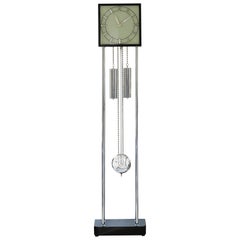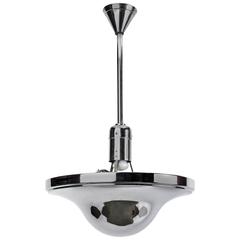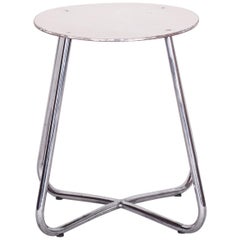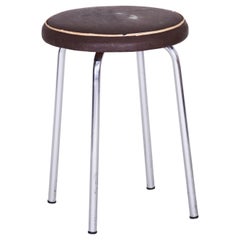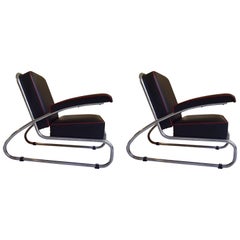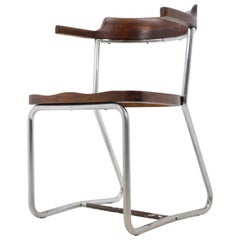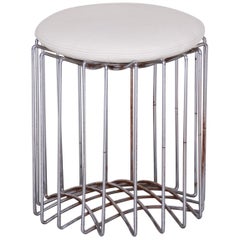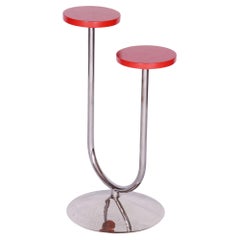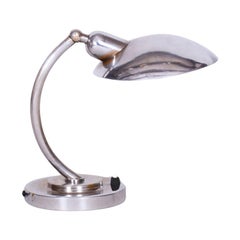Bauhaus Chrome
19
4,229
398
101
to
551
3,273
1,137
4,706
4,338
4,509
576
561
230
17
11
5
1
1
15
4,212
500
622
2,409
903
3
1
281
1,390
153
141
246
503
172
59
4,382
3,561
1,220
1,193
1,284
3,982
1,160
840
784
407
508
235
212
175
172
Sort By
'Bauhaus' Chrome Art Deco Longcase Clock
By Bauhaus
Located in Norwich, GB
‘Bauhaus’ Chrome Longcase Clock
Chrome and ebonized longcase clock resting on a heavy ebonised
Category
Vintage 1920s German Art Deco Grandfather Clocks and Longcase Clocks
Materials
Chrome
Extraordinary Bauhaus Chrome Pendant
By Bauhaus
Located in Kingston, NY
This extraordinary Bauhaus pendant features a mushroom shade in an original chrome finish.
Made in
Category
Vintage 1950s German Bauhaus Chandeliers and Pendants
Materials
Chrome
Small Round Bauhaus Chrome Stool by Vichr & Spol, Original Paint, 1930s
By Vichr & Spol
Located in Horomerice, CZ
Small round Bauhaus chrome stool.
Maker: Vichr & spol.
Category
Vintage 1930s Czech Bauhaus Stools
Materials
Chrome
Small Round Bauhaus Chrome Stool by Robert Sezák, Original Leather, 1940s
By Robert Slezák
Located in Horomerice, CZ
Small round Bauhaus chrome stool.
Maker: Robert Slezák.
Category
Vintage 1940s Czech Bauhaus Stools
Materials
Chrome
Pair of Gottwald Bauhaus Chrome Black Leather Lounge Chairs Red
By Hynek Gottwald
Located in Weiningen, CH
Pair of Bauhaus chrome black leather lounge chairs red by Gottwald. New reupholstered and recovered
Category
Vintage 1930s Czech Bauhaus Lounge Chairs
Materials
Chrome
Bauhaus Chrome Chair
By Robert Slezák
Located in Praha, CZ
- Czechoslovakia, 1930
- Maker: Robert Slezák
- see detailed pictures for condition
- published in catalogue (model K 16).
Category
Vintage 1930s Czech Bauhaus Chairs
Materials
Chrome
Unique White Round Bauhaus Chrome Stool, New High Quality Leather, 1930s
Located in Horomerice, CZ
Small round Bauhaus chrome stool.
Seat made of genuine leather.
The author is unknown
Category
Mid-20th Century German Bauhaus Stools
Materials
Chrome
Restored Bauhaus Chrome Flower Stand, Robert Slezak, Czechia, 1930s
By Robert Slezák
Located in Horomerice, CZ
Restored Bauhaus Chrome Flower Stand by Robert Slezak.
Maker: Robert Slezak
Period: 1930-1939
Category
Early 20th Century Czech Bauhaus Shelves
Materials
Steel, Chrome
Restored Bauhaus Chrome Table Lamp, F. Anyz, New Electrification, Czechia, 1920s
By Franta Anyz
Located in Horomerice, CZ
Restored Bauhaus Chrome Table Lamp Designed By Franta Anýž.
New Electrification.
Designer: Franta
Category
Vintage 1920s Czech Bauhaus More Mirrors
Materials
Steel, Chrome
H 10.63 in W 7.49 in D 12.21 in
Restored Bauhaus Chrome Trolley, Marcel Breuer, Mücke - Melder, Czechia, 1930s
By Marcel Breuer, Mücke & Melder
Located in Horomerice, CZ
Restored Bauhaus Chrome Trolley Deisgned by Marcel Breuer.
Designer: Marcel Breuer
Maker: Mücke
Category
Vintage 1930s Czech Bauhaus More Mirrors
Materials
Steel, Chrome
H 28.75 in W 34.65 in D 16.54 in
Bauhaus Chrome Coat Stand, 1920s
Located in Praha, CZ
Industrial coat rack from Bauhaus factory built in 1920s.
Original condition with losses on chrome
Category
Vintage 1920s Czech Bauhaus Coat Racks and Stands
Materials
Steel, Chrome
Bauhaus Chrome Coat Rack, 1930s
Located in Prague 8, CZ
For all Bauhaus lovers! A beautiful example of Bohemian pre-war functionalism represents this model
Category
Mid-20th Century Czech Bauhaus Coat Racks and Stands
Materials
Metal, Chrome
Functionalist/Bauhaus Chrome &Glass Chandelier
Located in Praha, CZ
Beautiful, elegant and simple Bauhaus chandelier, made of chrome and two kinds of glass. Very good
Category
Early 20th Century Czech Bauhaus Chandeliers and Pendants
Materials
Chrome
Design Bauhaus Chrome Pendant / 1930s
Located in Praha, CZ
- Original condition
- Checked, new electricity, polished
- Original glass shades
- Height can be shortened.
- around 1930s.
Category
Vintage 1930s European Bauhaus Chandeliers and Pendants
Materials
Metal, Chrome
Bauhaus Chrome Wall Lamp, 1930s
Located in Praha, CZ
- 1930
- good original condition
- new electricity
- jr.
Category
Vintage 1930s Czech Bauhaus Wall Lights and Sconces
Materials
Nickel
Original Art Deco Bauhaus Chrome Coat Rack Modernist, 1940s
By Bauhaus
Located in Saarburg, RP
clothes. This old original wall coat rack is chrome plated.
Beautiful timeless antique piece that will
Category
Early 20th Century Belgian Art Deco Coat Racks and Stands
Materials
Chrome
Bauhaus Chrome Window Pelmets or Consoles
Located in Praha, CZ
- 1930s
- Good original condition
- Coming from villa in Prag.
Category
Vintage 1930s European Bauhaus Windows
Materials
Brass, Chrome
Rare Bauhaus Chrome Pendant, 1930s, Restored
Located in Praha, CZ
Rare Bauhaus pendant made in Czechoslovakia in 1930s.
Minimalistic beautiful design.
Restored
Category
Vintage 1930s Czech Bauhaus Chandeliers and Pendants
Materials
Chrome
Mid Century Modern Mies Van Der Rohe Style Fasem Bauhaus Chrome Sling Rocker
By Ludwig Mies van der Rohe
Located in Chicago, IL
Mid Century Modern Mies Van Der Rohe Style Fasem Bauhaus Chrome Sling Rocker Newly Upholstered in
Category
Mid-20th Century American Mid-Century Modern Rocking Chairs
Materials
Chrome
1930s Bauhaus Chrome Table Lamp, Czechoslovakia
Located in Praha, CZ
Bauhaus or functionalist large table lamp made of chrome and beautiful, unique glass lamp shade
Category
Early 20th Century Czech Bauhaus Table Lamps
Materials
Chrome
Bauhaus Chrome Wall Light /Scone, 1930s
Located in Praha, CZ
- Czechoslovakia,
- 1930s
- Original condition with patina
- Rewired, opaline glass.
jr.
Category
Vintage 1930s Czech Bauhaus Wall Lights and Sconces
Materials
Chrome
Bauhaus Chrome and Glass Pendant, 1930s
Located in Praha, CZ
- Around 1930
- Original condition with patina
- Checked, new electricity, polished
- Original glass shades
- Height can be shortened.
Category
Vintage 1930s European Bauhaus Chandeliers and Pendants
Materials
Metal, Chrome
Art Deco Bauhaus Chrome Pendant, 1930s
Located in Praha, CZ
- Around 1930
- Original condition with patina
- Checked, new electricity, polished
- Original glass shades, marked by manufacturer
- Height can be shortened.
Category
Vintage 1930s European Bauhaus Chandeliers and Pendants
Materials
Metal, Chrome
Art Deco Bauhaus Chrome Pendant, 1930s
Located in Praha, CZ
- around 1930
- original condition with patina
- checked, new electricity, polished
- original glass shades,marked by manufacturer
- height can be shortened.
Category
Vintage 1930s European Bauhaus Chandeliers and Pendants
Materials
Metal, Chrome
Bauhaus Chrome Wall Lamp/Scone, 1930s
Located in Praha, CZ
- Czechoslovakia,
- 1930s
- Original condition with patina
- Rewired, opaline glass.
Category
Vintage 1930s Czech Bauhaus Wall Lights and Sconces
Materials
Chrome
Bauhaus Chrome Wall Lamp/Scone, 1930s
Located in Praha, CZ
- 1930s
- Czechoslovakia
- Good original condition with patina
- Repolished, rewired.
Category
Vintage 1930s Czech Bauhaus Wall Lights and Sconces
Materials
Chrome
Art Deco Era Vintage Bauhaus Chromed Metal Glass Bar Cart or Cart, 1930s Germany
Located in Vienna, AT
Art Deco Era vintage Bauhaus chromed metal black glass bar cart or cart, which was designed 1930s
Category
Vintage 1930s German Art Deco Carts and Bar Carts
Materials
Metal
H 27.96 in W 25.6 in D 17.72 in
Bauhaus Chromed Tubular Steel Dressing Table, 1940s
Located in Żory, PL
This Bauhaus style oak dressing table with mirror was produced in the 1940s in Czechoslovakia.
The
Category
Mid-20th Century Bauhaus Tables
Materials
Steel, Chrome
Design Bauhaus Chrome Wall Lamp, 1930s
Located in Praha, CZ
Made in Czechoslovakia
Made of glass, chrome
With Aged patina
1x75W, E27 or E26 bulb
New
Category
Vintage 1930s Art Deco Wall Lights and Sconces
Materials
Chrome
Art Deco Bauhaus Chrome Pendant, 1930s
Located in Praha, CZ
- 1930s
- perfect original condition
- original glass.
Category
Vintage 1930s Art Deco Chandeliers and Pendants
Materials
Chrome
1930's Bauhaus Chrome Wall Coat Hanger
Located in Praha, CZ
Chrome wall coat and hat hanger from former Czechoslovakia, made in th 1930's. Good condition
Category
Vintage 1930s Czech Bauhaus Hat Racks and Stands
Materials
Chrome
Bauhaus Chrome Window Pelmet or Console, 1930
Located in Praha, CZ
- Good original condition,
- 1930s
- Coming from villa in Prag.
Category
Vintage 1930s European Bauhaus Windows
Materials
Brass, Chrome
Bauhaus Chrome Chair by Robert Slezák, 1930s
By Robert Slezák
Located in Praha, CZ
- Czechoslovakia, 1930s
- Maker: Robert Slezák (marked)
- Published in catalogues
- New color with patina already (see the photos)
- Very early model, connected with small rivet.
Category
Vintage 1920s Czech Bauhaus Chairs
Materials
Chrome
Bauhaus Chromed Side Table, 1930's, Czechoslovakia
Located in Prague 8, CZ
Chrome side table with formica plate in the style of Marcel Breuer, made during the Bauhaus period
Category
Mid-20th Century Czech Bauhaus Side Tables
Materials
Chrome
Modern Bauhaus Chrome Coat Rack, Umbrella Stand
Located in Antwerp, BE
a great place for storing coats in a hall. The Bauhaus style offers a sleek chrome finish over a
Category
Vintage 1960s German Bauhaus Coat Racks and Stands
Materials
Metal, Chrome
Bauhaus Chrome Plated Coat Rack, 1930s, Czechoslovakia
Located in Prague 8, CZ
For all Bauhaus lovers! A beautiful example of Bohemian pre-war functionalism represents this model
Category
Mid-20th Century Czech Bauhaus Coat Racks and Stands
Materials
Metal, Chrome
Bauhaus Chromed Flower Stand, 1930's, Czechoslovakia
Located in Prague 8, CZ
An example of Czechoslovak functionalism is this model of a chrome- plated flower stand. The stand
Category
Mid-20th Century Czech Bauhaus Side Tables
Materials
Chrome
Tokyo Bauhaus Chrome table lamp 1980s Japan
By TS Tokyo
Located in Den Haag, NL
Chrome Table lamp Model Tokyo ,in the Bauhaus style . Comes with Three round glass
plates on .top
Category
Vintage 1980s Japanese Bauhaus Table Lamps
Materials
Chrome
Bauhaus Chrome Stool by Robert Slezák, 1930s
By Robert Slezák
Located in Praha, CZ
- 1930
- Czechoslovakia
- Maker: Robert Slezák, Bystrice p.Hostýnem
- Publicized in catalogues and books
- Reupholstered, polished.
Category
Vintage 1930s Czech Bauhaus Stools
Materials
Chrome
Bauhaus Chrome Coffee Table, 1930´s, Czechoslovakia
Located in Prague 8, CZ
plywood, seamless chromium steel tube. The table is in very good condition, the chrome showing slight
Category
Mid-20th Century Czech Bauhaus Coffee and Cocktail Tables
Materials
Steel, Chrome
Bauhaus Chrome Table Lamp, Czechoslovakia, 1930's.
Located in Praha, CZ
Adjustable Shade
Made of Chrome,Plastic
The lamp was completely disassembled and cleaned and
Category
Vintage 1930s Czech Bauhaus Table Lamps
Materials
Chrome
Design Bauhaus Chrome Pendant, 1930s / Czechoslovakia, Functionalism
Located in Praha, CZ
- Bauhaus, functionalism,
- 1930s
- Completely original condition
- Height can be shortened
Category
Vintage 1930s Czech Bauhaus Chandeliers and Pendants
Materials
Chrome
Bauhaus Chrome Adjustable Floor Lamp, 1930s / Functionalism
Located in Praha, CZ
- Functionalism, Bauhaus
- Czechoslovakia, 1930s
- Original condition, patina
- adjustable
Category
Vintage 1930s Czech Bauhaus Table Lamps
Materials
Chrome
Design Rare Bauhaus Chrome Table Lamp, 1930s
Located in Praha, CZ
- Czechoslovakia, 1930s
- perfect original condition
- New electricity
- Adjustable
jr.
Category
Vintage 1930s Czech Bauhaus Table Lamps
Materials
Chrome
Design Bauhaus Chrome and Glass Pendant, 1930s
Located in Praha, CZ
- Around 1930
- Original condition with patina
- Checked, new electricity, polished
- Original glass shades
- Height can be shortened.
Category
Vintage 1930s European Bauhaus Chandeliers and Pendants
Materials
Chrome, Metal
Design Bauhaus Chrome Wall Lamp / Scone, 1930s
Located in Praha, CZ
- 1930
- good original condition with patina
- opaline glass shade
- Rewired.
jt.
Category
Vintage 1930s Czech Bauhaus Wall Lights and Sconces
Materials
Chrome
1930s BIG Bauhaus chrome Table Lamp, Czechoslovakia
Located in Praha, CZ
- 1930s
- new electricity
- one bulb any wattage
- US adapter
jr
Category
Vintage 1930s Czech Bauhaus Table Lamps
Materials
Nickel
Bauhaus Chrome Window Pelmet or Console, 1930/Czechoslovakia
Located in Praha, CZ
- 1930s
- Good original condition with patina, polished
- Coming from villa in Prag.
Category
Vintage 1930s European Bauhaus Windows
Materials
Brass, Chrome
Very Rare Tubular Steel Bauhaus Chrome Chair, 1930s
By Rudolf Vichr
Located in Praha, CZ
- 1930, Czechoslovakia
- Maker: Rudolf Vichr, Prague
- Original condition
- Original red iron yarn, fabric /eisengarn
- All screws original
- Suitable for collectors
- Publicat...
Category
Vintage 1930s Czech Bauhaus Chairs
Materials
Chrome
Rare Bauhaus Chrome Table by Robert Slezak, 1930
By Slezak Company
Located in Praha, CZ
- 1930s
- Czechoslovakia
- Maker: Robert Slezák
- Publicated in catalogues and books
- Renovated desk with new veneer
- Marked by a stamp.
Category
Vintage 1930s Czech Bauhaus Tables
Materials
Chrome
Fully Restored Blue Bauhaus Chrome Sofa, 1930s Czechia
Located in Horomerice, CZ
Bauhaus style sofa with chrome tubular steel frame.
Manufactured in the 1930s.
Chrome tubular steel
Category
20th Century Czech Bauhaus Sofas
Materials
Chrome
Bauhaus Chromed Coffee Table by Robert Slezak, 1930s
By Slezak Company
Located in Prague 8, CZ
features a chrome-plated metal base and a walnut top plate. Chrome structure is in very good Vintage
Category
Vintage 1930s Czech Bauhaus Coffee and Cocktail Tables
Materials
Chrome
Bauhaus Chromed Coffee Table by Robert Slezak, 1930s
By Robert Slezák, Kovona
Located in Prague 8, CZ
in the 1950s by the famous company Kovona. The table features a chrome-plated metal base and dark
Category
Mid-20th Century Czech Bauhaus Coffee and Cocktail Tables
Materials
Chrome
Bauhaus Chrome Mücke & Melder Stool, Mart Stam / Signed
By Mücke & Melder
Located in Praha, CZ
- Designer: Mart Stam
- Czechoslovakia
- Fy Mücke & Melder
- Completely good original condition.
Category
Vintage 1930s Czech Bauhaus Stools
Materials
Chrome
Bauhaus Chromed Coffee Table by Robert Slezak, 1930s
By Kovona, Robert Slezák
Located in Prague 8, CZ
in the 1950s by the famous company Kovona. The table features a chrome-plated metal base and dark
Category
Mid-20th Century Czech Bauhaus Coffee and Cocktail Tables
Materials
Metal, Chrome
Rare Large Bauhaus Chrome-Plated Tubular Chandelier, 1930s
Located in Praha, CZ
Unique beautiful huge Bauhaus chandelier with two separate circuits - 6+6 40W, E25-E27 bulbs
Category
Vintage 1930s Czech Bauhaus Chandeliers and Pendants
Materials
Chrome
Bauhaus chrome lamp by Miroslav Prokop for Napako
By Napako
Located in PRAHA 5, CZ
Minimalist chrome plated table lamp designed by Czech architect Miroslav Prokop for Napako company
Category
Vintage 1930s Czech Bauhaus Table Lamps
Materials
Steel, Chrome
Antique Art Deco Bauhaus Chrome Coat Rack / Hat Rack 1930 Design Hallway Hanger
By Bauhaus
Located in Ijzendijke, NL
Gorgeous fully original Art Deco Bauhaus coat rack in Chrome from the 1930s.
Marvelous Art Deco
Category
Vintage 1930s German Art Deco Coat Racks and Stands
Materials
Chrome
Free Shipping
H 9.45 in W 49.22 in D 10.83 in
Antique Art Deco Bauhaus Chrome Coat Rack / Hat Rack Design Hallway 1930 Germany
By Bauhaus
Located in Ijzendijke, NL
Gorgeous fully original Art Deco Bauhaus coat rack in chrome from the 1930s.
Marvelous Art Deco
Category
Vintage 1930s German Art Deco Coat Racks and Stands
Materials
Metal, Chrome
Free Shipping
H 7.09 in W 39.57 in D 9.65 in
Unique Bauhaus Chrome and Glass Chandelier/Pendant, 1930s
Located in Praha, CZ
- 1930s
- Czechoslovakia
- Perfect original condition, patina
- Newly wired.
Category
Vintage 1930s Czech Bauhaus Chandeliers and Pendants
Materials
Chrome
- 1
- ...
Get Updated with New Arrivals
Save "Bauhaus Chrome", and we’ll notify you when there are new listings in this category.
Bauhaus Chrome For Sale on 1stDibs
With a vast inventory of beautiful furniture at 1stDibs, we’ve got just the bauhaus chrome you’re looking for. Each bauhaus chrome for sale was constructed with extraordinary care, often using metal, chrome and wood. There are 1108 variations of the antique or vintage bauhaus chrome you’re looking for, while we also have 85 modern editions of this piece to choose from as well. You’ve searched high and low for the perfect bauhaus chrome — we have versions that date back to the 19th Century alongside those produced as recently as the 21st Century are available. When you’re browsing for the right bauhaus chrome, those designed in Art Deco, Mid-Century Modern and Modern styles are of considerable interest. You’ll likely find more than one bauhaus chrome that is appealing in its simplicity, but Marcel Breuer, Poul Henningsen and Ludwig Mies van der Rohe produced versions that are worth a look.
How Much is a Bauhaus Chrome?
A bauhaus chrome can differ in price owing to various characteristics — the average selling price 1stDibs is $1,890, while the lowest priced sells for $240 and the highest can go for as much as $160,973.
More Ways To Browse
Opaline Glass Flush Mount Ceiling Lamps
Glass Tubes Wall Lamps
Wall Lamp Milk Glass
Night Stands Set 2
J Halabala
French Wall Scones
Thonet Upholstered Armchair
Czech Chrome Chair
Tubular Writing Desk
Smoked Glass Coffee Table Round
Coffee Table In Dark Oak
Three Door Vintage Wardrobe
Plant Console
Red Leather Pair Lounge Chairs
Metal Frame School Chair
Retro Wooden Bedside Tables
Retro Wooden Bedside Table
1930s Vintage Clothes
